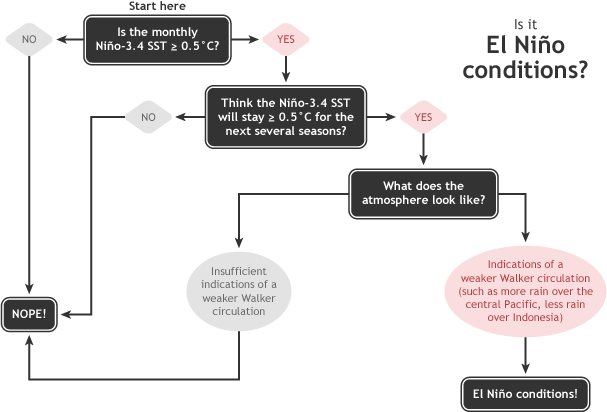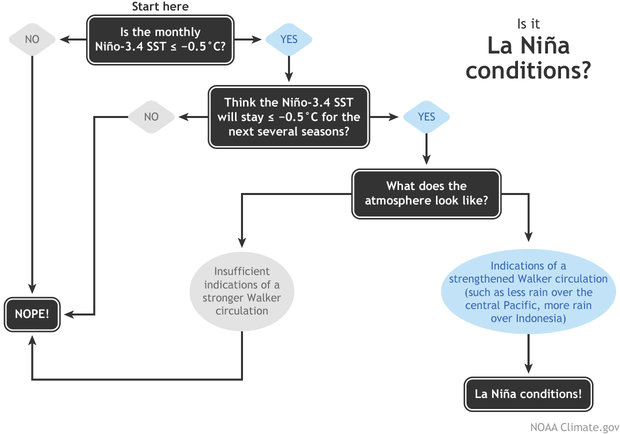El Niño and La Niña Alert System
On the second Thursday of each month, scientists with NOAA’s Climate Prediction Center in collaboration with forecasters at the International Research Institute for Climate and Society (IRI) release an official update on the status of the El Niño-Southern Oscillation (ENSO for short). Here is a description of the categories and criteria they use.
- Watch: Issued when conditions are favorable for the development of El Niño or La Niña conditions within the next six months.
- Advisory: Issued when El Niño or La Niña conditions are observed and expected to continue.
- Final advisory: Issued after El Niño or La Niña conditions have ended.
- Not Active: ENSO Alert System is not active. Neither El Niño nor La Niña are observed or expected in coming 6 months.
El Niño criteria
- Average sea surface temperatures in the Niño-3.4 region of the equatorial Pacific Ocean (5°N-5°S, 120°W-170°W) were at least 0.5°C (0.9°F) warmer than average in the preceding month, and
- the anomaly has persisted or is expected to persist for several overlapping 3-month periods (e.g., DJF, JFM, FMA, etc), and
- the atmosphere over the tropical Pacific exhibits one or more of the changes commonly associated with El Niño:
- weaker than usual easterly trade winds,
- reduced cloudiness and rainfall over Indonesia and a corresponding increase in the average surface pressure, or
- increased cloudiness and rainfall in central or eastern part of the basin and a corresponding drop in the average surface pressure.
Summary of NOAA decision process in determining El Niño conditions. NOAA Climate.gov drawing by Glen Becker and Fiona Martin.
La Niña criteria
- Average sea surface temperatures in the Niño-3.4 region of the equatorial Pacific Ocean (5°N-5°S, 120°W-170°W) were at least 0.5°C (0.9°F) cooler than average in the preceding month, and
- an average anomaly of at least -0.5°C has persisted or is expected to persist for several overlapping 3-month periods (e.g., DJF, JFM, FMA, etc), and
- the atmosphere over the tropical Pacific exhibits changes commonly associated with La Niña, including one or more of the following:
- stronger than usual easterly trade winds,
- an increase in cloudiness and rainfall over Indonesia and a corresponding drop in average surface pressure,
- a decrease in cloudiness and rainfall in the eastern tropical Pacific, and an increase in the average surface pressure.


